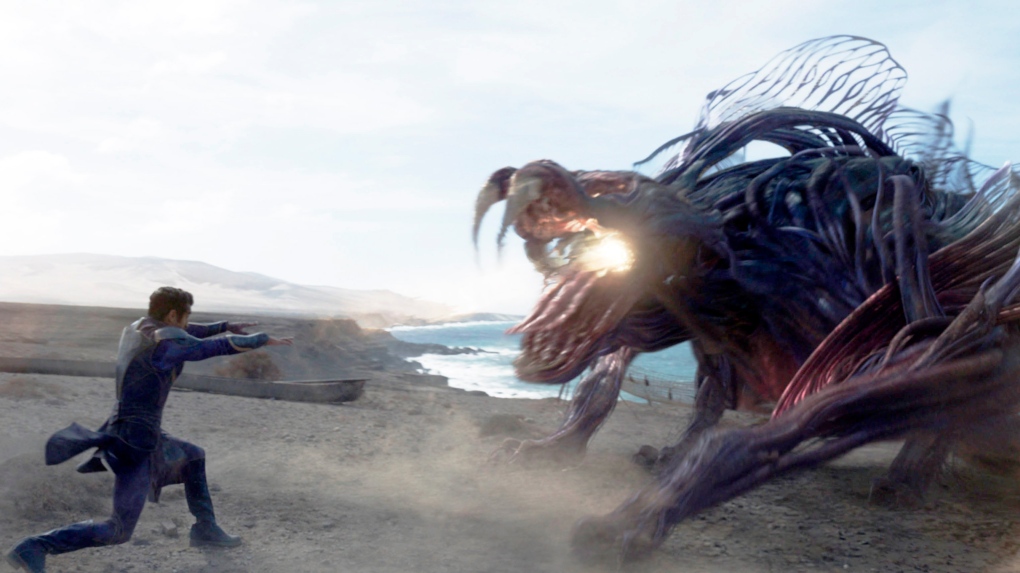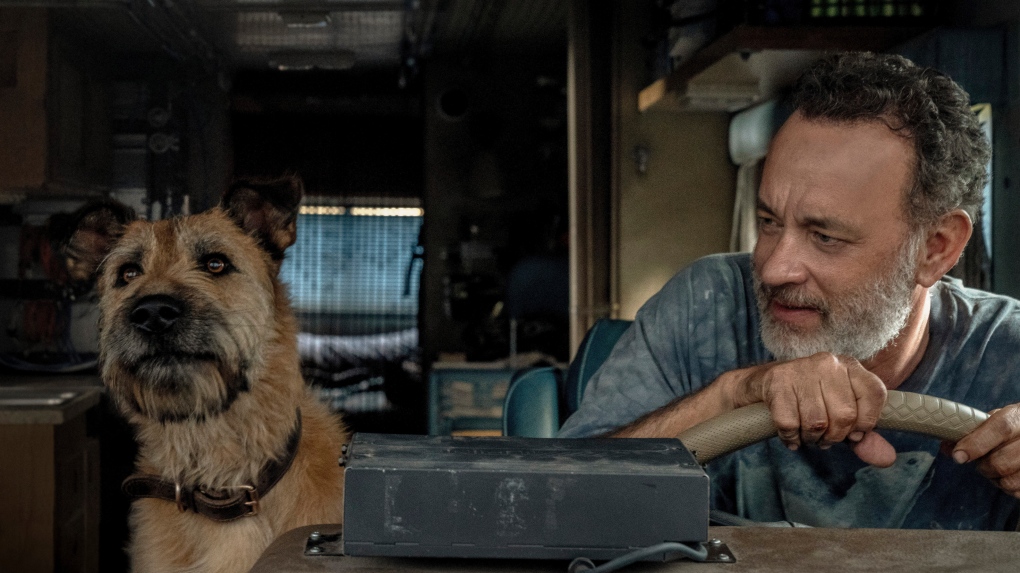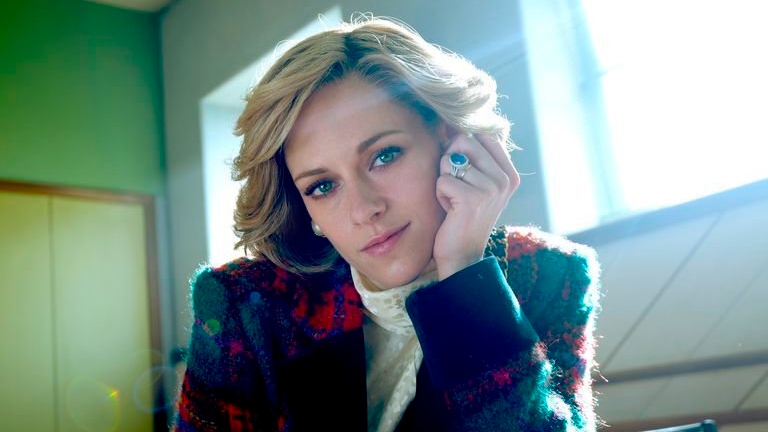ETERNALS: 3 STARS
 This image released by Marvel Studios shows Kumail Nanjiani in a scene from "Eternals." (Marvel Studios via AP)
This image released by Marvel Studios shows Kumail Nanjiani in a scene from "Eternals." (Marvel Studios via AP)
The Marvel Cinematic Universe expands this weekend with the theatrical release of “Eternals,” a star-studded superhero film with thousands of years of backstory and 10 new-to-the-big-screen superheroes.
For the uninitiated -- those who don’t know their Jack Kirby from their Bruno Kirby -- the Eternals have existed in comic book form since 1976.
They are 10 immortals lead by matriarch Ajak (Salma Hayek) and Ikaris (Richard Madden). Rounding out the diverse cast (who are often lined up on-screen like they are posing for a 1980s album cover shoot) are matter manipulator Sersi (Gemma Chan); Thena (Angelina Jolie), a warrior with super strength and the ability to fly; strongman Gilgamesh (Don Lee); Makkari (Lauren Ridloff), the fastest woman in the universe; Bollywood star Kingo (Kumail Nanjiani) who can shoot fireballs from his palms; the childlike ancient Sprite (Lia McHugh); master inventor Phastos (Brian Tyree); mind control expert Druig (Barry Keoghan); and Sersi’s human (or is he?) boyfriend Dane Whitman (Kit Harington).
Pay attention. You may need a scorecard to keep track.
They were sent to Earth 7,000 years ago by the all-powerful Prime Celestial Arishem (voiced by David Kaye) to keep humans safe from evil, killing creatures called Deviants. Over the years, they have been present at many defining world events, from ancient battles to Hiroshima. They live by a strict set of rules, including a prime directive of a sort that instructs them to only protect humans from Deviants. That means no man-on-man conflict. If they interfere with earthly concerns, Arishem says, humans will never figure out how to protect themselves.
When the Eternals vanquished the Deviants, they went undercover, blending in with the normies for eons.
Now, in present day, the Deviants are back and badder than they ever were -- this time around they can heal themselves -- but can the Eternals battle the deadly invaders while pondering the real reason Arishem put them on Earth in the first place?
The 25th epic in the Marvel Cinematic Universe spans millennia, but tackles many current issues. Themes of unity and the power of connection are woven into the story, topped with messages of self-awareness and being who you are. The ten new superheroes are more introspective than your run-of-the-mill super being, expressing their innermost feelings when they aren’t grappling with the existential threat posed by the Deviants. I mean, when was the last time you saw a superhero cry? The ideas expressed regarding sacrifice, interventionism and purpose of mission are endlessly replayed, but never truly explored. It is pop psychology disguised as depth.
But, nonetheless, they take the time to pontificate. At two hours and 37 minutes, “Eternals’” story doesn’t exactly feel like it takes an eternity to tell, but it does feel long, especially if you stay to the end to see the two post credit scenes.
Oscar winning director Chloé Zhao, who also co-wrote the script, brings humanity to these alien creatures, but the blockbuster style action, endless exposition and humanist musings sit uneasily beside one another. It’s ambitious, but tonal shifts abound and by the time the CGI orgy of the finale gets underway, “Eternals” simultaneously feels like too much and too little.
FINCH: 3 ½ STARS
 This image released by Apple TV+ shows Tom Hanks in a scene from "Finch." (Karen Kuehn/Apple TV+ via AP)
This image released by Apple TV+ shows Tom Hanks in a scene from "Finch." (Karen Kuehn/Apple TV+ via AP)
“Finch,” the new Tom Hanks dystopian drama now streaming on Apple TV+, feels like a mix of “Castaway” and “Short Circuit.”
Set in the near future, the movie takes place in a world where a catastrophic solar flare devastated the planet. Temperatures reaching 60 degrees Celsius are commonplace and most people are dead, burnt to a crisp, leaving behind desiccated corpses. Those who are left, like Finch (Hanks), must scavenge for food and supplies. Finch, an engineer and inventor, lives in a bunker with his best (and only) friend, a cute dog named Goodyear.
When he isn’t driving around in his armoured vehicle -- a giant RV with solar panels -- exploring the burnt-out area around his home for any morsels that might have been left behind, he is working in the lab, building a robot.
Finch isn’t tinkering with the droid to pass the time. He’s sick, slowly dying of radiation poisoning and building a machine to care for Goodyear once he is unable.
Slapped together with spare parts, the robot (Caleb Landry Jones), with his elongated face and camera lens eyes, is a gangly contraption, child-like in his awareness of the strange new world to which he is introduced.
As Finch’s health worsens so does the situation outside his doors. As temperatures rise and the weather becomes more and more unstable, Finch, Goodyear and the robot, who goes by the name Jeff, hit the road and head towards San Francisco.
The trip is fraught with danger and made no less easy by Jeff’s learning curve. He’s not always the droid Finch is looking for. “I know you were born yesterday,” says an exasperated Finch, “but I need for you to grow up!”
Despite the high tech aspects of the story -- the robotics and mysterious cause of the dystopia -- “Finch” is an old-fashioned movie. The action sequences are old school, man-against-nature style, as Finch and his ragtag team battle tornadoes, UV radiation and extreme weather in the hellish, post-apocalyptic wasteland.
More than that, “Finch” is not really about the robot. It is about making a connection -- human or otherwise – determination, and legacy.
Ensuring that the movie has some heart and soul is Hanks. He is in virtually every frame of the film, and his empathic likability shines through. There’s not a lot of backstory -- any background is told in the form of stories to teach Jeff a life lesson -- but Hanks, through his expressive eyes, provides all the details we need.
Landry Jones, in a motion capture performance, brings a great deal of heart and humour to the mechanical Jeff as he figures out the nuts-and-bolts of day-to-day life. The father and son bond between him and Finch brings both the joy and sorrow of relationships to the forefront, and goes beyond the usual buddy movie clichés into something deeper.
“Finch” is a different kind of post-apocalyptic movie. In fact, it may be the most jovial end of the world flick ever. Finch and Jeff lightheartedly joust back and forth, which leads to some sappy moments, but at the end of the day, it’s about their relationship. And let’s face it, if Hanks could make us care about a volleyball in “Castaway,” he can make you fall for a CGI robot.
SPENCER: 4 STARS
 This image released by Neon shows Kristen Stewart in a scene from "Spencer." (Pablo Larrain/Neon via AP)
This image released by Neon shows Kristen Stewart in a scene from "Spencer." (Pablo Larrain/Neon via AP)
Kristen Stewart may always be best known for playing Bella Swan, the young woman who fell in love with a vampire in the “Twilight” series, but if that lifestyle choice seemed scary, it has nothing on the atmosphere of dread in her new movie. “Spencer,” a new impressionistic biopic of Diana, Princess of Wales, (born Diana Spencer) and now playing in theatres, sees her embroiled in a tale of real-life Gothic horror.
It’s Christmas 1991 at Sandringham House, one of Queen Elizabeth II’s country homes. The Royal Family has assembled for their annual holiday celebrations, complete with protocols, paparazzi, strange Royal traditions, disapproving looks, a ghost and the prying eyes of an equerry, Major Alistair Gregory (Timothy Spall). Despite being surrounded by people, including husband Prince Charles (Jack Farthing) and sons Prince William (Jack Nielen) and Prince Harry (Freddie Spry), she feels alone, with the exception of her single confidant Maggie (Sally Hawkins), Diana's tailor and best friend.
It is, as a title card tells us, a “fable based on a real tragedy,” and over the course of almost two hours we experience Diana’s life years after the fairy tale wedding. Her marriage is crumbling, she is battling an eating disorder and the gap between perception of her private life and public persona is widening.
That Sandringham is located next to Park House, the home she grew up in and harbours many happy memories of, only deepens the wellspring of sorrow she feels as her life spins out of control.
“Spencer” is a portrait of the Princess of Wales at her most vulnerable and isolated, but it never feels as though it is exploiting Diana. The director, Chilean auteur Pablo Larraín, working from a script by “Eastern Promises” writer Steven Knight, doesn’t turn her life into a pity party. The character is having a rough time equating her life and the future of her children with the reality of her situation, yet she perseveres. In the moments away from the protocols of Royal life -- mommy time with Prince William and Prince Harry, or on a trip to the beach with Maggie -- the veil lifts and she becomes Diana Spencer, able to leave the titles and tradition in the dust.
Stewart nails the voice and mannerisms, but doesn’t try to imitate Diana, one of the world’s best-known people. Instead, she reaches deep to delicately create a portrait of a person riddled with anxiety at a crossroads in her life. Stewart, whose own experiences with an intrusive press and paparazzi have been well documented, brings that lived experience to the film. Stewart’s face during a photo call scene outside a church says it all, expertly showing the mix of duty and terror Diana must have felt towards the press who hounded her.
“Spencer” is a heightened look at Diana’s life, but it’s not all Sturm und Drang. The script is laced with Diana’s sarcastic sense of humour and the beautiful cinematography provides a somewhat serene backdrop to the coolly chaotic action. But make no mistake, the story’s underlying tension, despite a rather joyous finale, has more to do with a psychological horror film than a traditional biopic.














































